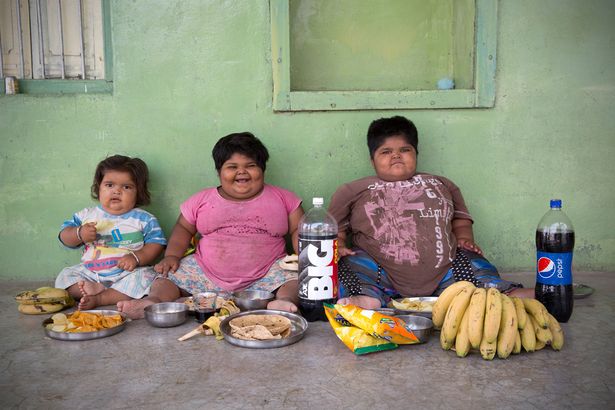India beat USA to have 2nd highest no. of obese children.
1 in 5 adults overweight in India.
Urban population is more prone to obesity as compared to their rural
Middle class more at risk of obesity
Double burden-obese and Undernourished Nation
Overweight and obesity are defined as abnormal or excessive fat accumulation that presents a risk to health. A crude population measure of obesity is the body mass index (BMI), a person’s weight (in kilograms) divided by the square of his or her height (in metres). A person with a BMI of 30 or more is generally considered obese. A person with a BMI equal to or more than 25 is considered overweight.
Overweight and obesity are major risk factors for a number of chronic diseases, including diabetes, cardiovascular diseases and cancer. Once considered a problem only in high income countries, overweight and obesity are now dramatically on the rise in low- and middle-income countries, particularly in urban settings.
Even as India battles malnutrition, the country has developed another nutritional problem—obesity. In past 10 years, the number of obese people has doubled in the country, according to the National Family Health Survey (NFHS-4). The survey highlights that urban population is more prone to obesity as compared to their rural counterparts.
According to study published in Lancet journal India and China continue to have the largest number of underweight people in the world, both the countries have also broken into the top five in terms of obesity. India has 0.4 million obese men, or 1.3% of the global obese population in 1975, but in 2014, it zoomed into the fifth position with 9.8 million obese men, or 3.7% of the global population. Among women, India has jumped to the third rank with 20 million obese women (5.3% of global population). The study looked at BMI (body mass index) trends in 200 countries from 1975-2016. It found that worldwide the number of obese girls in age group 5-19 has risen from 5 million to 50 million in 40 years, and boys from 6 million to 74 million.
Middle class more at risk of obesity
According to study published in PLOS ONE journal, conducted on children of hospital staff in New Delhi found that under-nutrition was common among the economically-disadvantaged housekeepers. It also found that while children of doctors tended to be normally nourished, those belonging to nurses were overweight. The majority of obese children belonged to middle class.
India facing a double burden of disease
Children in low- and middle-income countries are more vulnerable to inadequate pre-natal, infant, and young child nutrition. At the same time, these children are exposed to high-fat, high-sugar, high-salt, energy-dense, and micronutrient-poor foods, which tend to be lower in cost but also lower in nutrient quality. These dietary patterns, in conjunction with lower levels of physical activity, result in sharp increases in childhood obesity while undernutrition issues remain unsolved.
Health risks associated with obesity
- Diabetes
- High blood pressure
- High cholesterol
- Heart disease
- Stroke
- Gallbladder disease
- Osteoarthritis
- Sleep apnea and respiratory problems
What causes obesity?
Genetics: Obesity has a strong genetic component. Offsprings of obese parents are much more likely to become obese than offsprings of lean parents.
Behaviors: The main aspects of healthy behaviors are a healthy diet and regular physical activity. Failing to adhere to these guidelines by eating an unhealthy diet and not exercising enough, increases the risk of overweight or obesity.
Disease: Certain diseases can lead to a person becoming overweight or obese.
Junk Food: The fact is that junk foods can cause full-blown addiction in susceptible individuals. People lose control over their eating behavior, in the same way as alcoholics lose control over their drinking behavior.
Medications: Certain medications such as antidepressants and steroids can lead to weight gain.
Inactivity: If you're not very active, you don't burn as many calories. With a sedentary lifestyle, you can easily take in more calories every day than you use through exercise and normal daily activities.
How can overweight and obesity be reduced?
· At the individual level, people can:
- limit energy intake from total fats and sugars;
- increase consumption of fruit and vegetables, as well as legumes, whole grains and nuts; and
- engage in regular physical activity (60 minutes a day for children and 150 minutes spread through the week for adults).
Source: Down To Earth, WHO, Times of India, Obesity foundation India, healthline.com, mayoclinic.org
